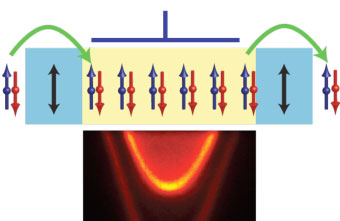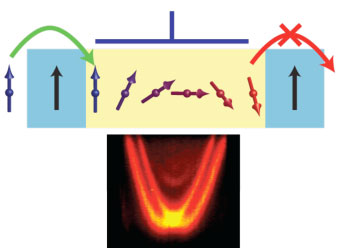| Aug 29, 2011 |
A new spin on topological insulator surfaces
|
|
(Nanowerk News) A European team of researchers has discovered that properties of the so-called topological insulator bismuth selenide could provide the solution to how a ground-breaking new computing technology called 'spintronics' can work at room temperature. This is a solution scientists have been waiting for ever since the technology was predicted more than two decades ago.
|
|
Virtually all microelectronics are currently based on the commonly known transistor, which works by regulating the flow of electricity in a semiconductor with the help of a small external voltage. For decades, researchers have been trying to update the transistor so that it uses another fundamental property of electrons – namely their rotation called 'spin', rather than their electric charge. However, reaching their target has proved to be elusive because this spin effect – known as the Rashba effect – is miniscule. The electrons therefore have to cover quite long distances to feel the effect, at the same time as being kept in their path. Until now, this has meant that it has only been possible to make spintronic transistors work at temperatures around -270°C, i.e. close to absolute zero. This obviously makes them unsuitable for use in everyday electronic devices.
|
|
Spintronics on the nanoscale – and at room temperature
|
|
The latest research results of Professor Philip Hofmann (Department of Physics and Astronomy and iNANO, Aarhus University) and his colleagues have just been published in the journal Physical Review Letters. In two articles ("Large Tunable Rashba Spin Splitting of a Two-Dimensional Electron Gas in Bi2Se3" and "Simultaneous Quantization of Bulk Conduction and Valence States through Adsorption of Nonmagnetic Impurities on Bi2Se3"), they show that bismuth selenide – a material developed as a so-called topological insulator – is capable of generating a Rashba effect that is more than a hundred times stronger than in other semiconductor materials and, what is more, at room temperature. This sets the stage for developing spin field effect transistors (SpinFETs) that can work at realistic temperatures and right down to the nanoscale, thereby creating an opportunity for the spintronic effect to be used in everyday devices in homes and not just under controlled conditions in a physics lab.
|
 |
| Electronics: In the current version of electronics, the flow of electricity through a transistor can be controlled by means of a small charge on the blue switch (at the top). This attracts electrons and enables conduction. The rotation of the electrons (their spin, symbolised by arrows) is unimportant for the function. The coloured image underneath shows the electrons in the yellow channel, measured by synchrotron radiation from ASTRID (Aarhus University's synchrotron radiation facility).
|
|
Serendipity
|
|
As with so many other scientific discoveries throughout the course of time, this property of the material bismuth selenide was discovered by chance. In recent times, bismuth selenide has been studied in more detail by material physicists because it is one of the few known materials that belongs to the class of so-called topological insulators. A topological insulator is a material that insulates inside, but conducts on the surface. The spin and momentum of the electrons on the surface are connected in such a way that backscattering from ordinary defects cannot take place. Topological insulators therefore have application aspects in electronics, where heat development could be minimised and thereby energy consumption as well. However, the recently discovered spintronic effect is not actually related to the properties of bismuth selenide as a topological insulator – it is also found in other semiconductors. It is just that nobody has studied this property in bismuth selenide until now, which means this could turn out to be the first practical application of the recently discovered topological insulators.
|
 |
| Spintronics: In the spintronics of the future, a small charge on the blue switch leads to a spin rotation when the electrons move through the transistor. This rotation can be controlled, and it decides whether the electrons can enter the right part of the transistor or not. The coloured image shows the distribution of the electrons in the yellow channel. The clear splitting compared with the ordinary transistor is what is required to achieve a spin rotation.
|
|
Faster and more energy-efficient computers
|
|
A transistor based on spintronics has a number of advantages compared with more familiar electronics. It could be possible to make faster and more energy-saving processors for computers, but there are also numerous ideas for new applications that utilise the special properties of topological insulators. "Electronics as we know it today has reached a point where development is taking place slowly and in small steps. There are plenty of interesting theoretical ideas for new directions, but we don't have the materials to implement them. Topological insulators could very well provide us with the opportunity to move on, and that makes discovering their many new properties really exciting," says Professor Hofmann.
|
|
There is still a long way to go before devices based on spintronics will be available in the shops. With the rapid development in research taking place at present, however, it is possible that this will happen sooner than anyone would dare predict today.
|


